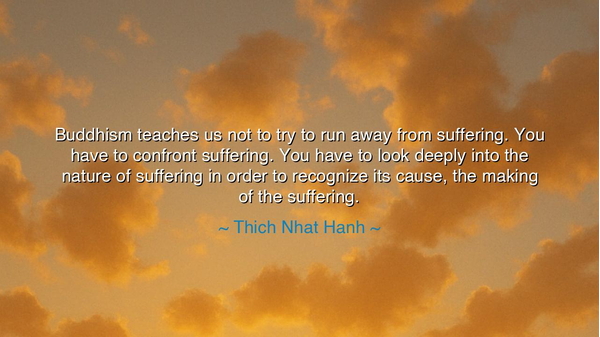
Buddhism teaches us not to try to run away from suffering. You
Buddhism teaches us not to try to run away from suffering. You have to confront suffering. You have to look deeply into the nature of suffering in order to recognize its cause, the making of the suffering.






Hear, O children of the Way, the timeless words of the gentle master Thich Nhat Hanh: “Buddhism teaches us not to try to run away from suffering. You have to confront suffering. You have to look deeply into the nature of suffering in order to recognize its cause, the making of the suffering.” In this saying, there is not despair, but a call to courage. For suffering is not an enemy to be denied nor a shadow to be fled, but a teacher, stern yet compassionate, who points the seeker toward truth.
Many, when they feel pain, attempt to escape. They drown it in distraction, they bury it beneath pleasures, they harden their hearts so they cannot feel. But what is buried is not destroyed—it festers, it deepens, it whispers in the dark. The Buddha himself, before enlightenment, saw that to deny suffering was to remain enslaved to it. Only by turning toward it with clear eyes, only by tracing it to its root, could one find liberation. Thus the noble path begins not with avoidance, but with acknowledgment: life contains suffering, yet suffering can be understood and transcended.
Consider the life of the Buddha under the Bodhi tree. There he did not flee from his torments but faced them: desire, fear, hunger, doubt, and even Mara, the great tempter of illusion. All arose before him, yet he did not run. He gazed deeply into their nature until he understood their origin in craving and ignorance, and in that moment, their power was broken. By confronting rather than fleeing, he discovered the root of sorrow and, in discovering, transcended it. His victory was not over the world, but over the chains of the mind.
So too in our times we find lessons. Think of Nelson Mandela, imprisoned for twenty-seven years. He could have drowned in bitterness, fled into hatred, or broken under despair. Instead, he confronted his suffering and looked deeply into its cause—not only his personal pain, but the system of injustice that produced it. By facing suffering without fleeing, he emerged not shattered but tempered like steel. When freedom came, he chose not revenge but reconciliation, for he had transformed his pain into wisdom. His life echoes the same truth: only by facing suffering can we redeem it.
The lesson is thus: do not run from your pain, for to run is to be forever pursued. Instead, sit with it, breathe with it, inquire into its source. Ask: “What gives rise to this sorrow? What craving, what fear, what illusion?” By understanding its making, you loosen its grip. In this way, even the deepest wounds become teachers, showing the path toward freedom.
Yet beware: to confront suffering is not to wallow in it. The purpose is not endless lament, but clarity. Just as a healer examines the wound not to admire it but to cure it, so must you look into your suffering to release it. In this practice, compassion for yourself is born, and from compassion for yourself arises compassion for others, for you see in their pain the same roots that dwell in your own.
Practical action follows: when pain arises, do not numb it with endless distractions. Instead, take a quiet moment. Breathe deeply. Name your suffering. Ask where it comes from, and what feeds it. Seek wise counsel, practice mindfulness, and let your awareness shine upon the darkness. Slowly, the roots will be revealed, and once revealed, they may be cut. In this way, suffering becomes the doorway to awakening.
So remember, O seekers: suffering is not your jailer, but your teacher. Do not flee, but face it. Do not curse it, but understand it. And in that understanding, you will discover the path of liberation, where the heart is free and the soul moves in peace with all beings.






AAdministratorAdministrator
Welcome, honored guests. Please leave a comment, we will respond soon